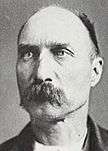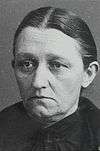John and Sarah Makin
John Makin (14 February 1845 – 15 August 1893) and Sarah Jane Makin (20 December 1845 – 13 September 1918) were Australian baby farmers who were convicted in New South Wales (NSW) for the murder of infant Horace Murray. Both were tried and found guilty in March 1893 and were sentenced to death. John was hanged on 15 August 1893 but Sarah's sentence was commuted to life imprisonment. On 29 April 1911, Sarah was paroled from the State Reformatory for Women at Long Bay in response to the petition of her daughters.[1]
John and Sarah Makin   | |
|---|---|
John and Sarah Makin in the 1890s. | |
| Born | 14 February 1845 (John) 20 December 1845 (Sarah) |
| Died | 15 August 1893 (aged 48) (John) 13 September 1918 (aged 72) (Sarah) New South Wales, Australia |
| Occupation | Drayman (John) Midwife (Sarah) |
| Criminal status | Hanged on 15 August 1893 (John) Paroled on 29 April 1911 (Sarah) |
| Children | 5 sons, 5 daughters |
| Parent(s) | William Samuel and Ellen Selena Bolton Makin (John) Emanuel and Ellen Murphy Sutcliffe (Sarah) |
| Conviction(s) | Murder – March 1893 |
| Criminal penalty | Capital punishment |
Background
Sarah Jane Sutcliffe was born on 20 December 1845 to Ellen Murphy and Emanuel Sutcliffe; her father was a miller and former convict. Sarah's first marriage was to sailor Charles Edwards on 29 April 1865 in Sydney. She later married brewery drayman John Makin of Dapto, New South Wales, on 27 August 1871. John was the son of farmer William Samuel Makin and his wife Ellen Selena. John and Sarah produced five sons and five daughters. The couple turned to baby farming—the practice of caring for illegitimate babies in exchange for payment—as a source of income after John was injured in an accident.[1]
Case of Horace Murray
In 1892, eighteen-year-old Amber Murray placed an advertisement in the Sydney Morning Herald in search of a mother to adopt a baby boy.[2] Murray was unable to care for her illegitimate son Horace, born on 30 May of that year, and offered to cover child support expenses.[1] The Makins replied that they were willing to take care of Horace for ten shillings per week.[2] Daughter Blanche Makin accepted an initial payment of three pounds and collected the child.[1] John Makin continued to collect child support payments from Amber Murray while responding to her requests to see Horace with excuses. When Murray visited an address near Sydney the Makins had provided, the family had moved to Macdonaldtown, NSW, and could not be found.[3] Murray never saw her baby alive again.[2]
Discovery of bodies
The Makins came to police attention on 11 October 1892, when worker James Hanoney was clearing a clogged underground drain in the backyard of a home in Burren Street, Macdonaldtown, and found it blocked with the remains of two infants.[2] Investigators examined records to trace the Makins, who had moved again to Chippene. The Makins and four of their daughters were arrested, though only John and Sarah were charged.[2] Police exhumed remains from the backyards of eleven homes that the Makins had occupied since 1890.[1] The bodies of twelve infants were recovered,[2] though some sources say thirteen.[1] Prosecutors believed the Makins sought to profit by taking in babies for childcare payments, and found it easier to kill the children and deceive the parents to continue receiving money.[2] One of their victims was Horace Murray, whose clothing was identified by his mother Amber.[3]
Trial
In March 1893, the Makins' daughters testified against them in court. Sixteen-year-old Clarice said she recognised clothing recovered from one of the dead babies that was previously in the custody of her mother. Eleven-year-old Daisy recalled that two young girls—but not Horace—had followed them to Macdonaldtown. Another couple testified that they had been paying the Makins ten shillings per week for the temporary care of their illegitimate baby. The child died within days and the couple paid the Makins two pounds to cover funeral costs. The Makins did not attend the funeral.[3]
Sentencing
Both Sarah and John Makin were sentenced to death by hanging by the Supreme Court of New South Wales at Sydney for the murder of Horace Murray, with a recommendation by the jury that Sarah Makin be spared the death penalty.[1] Before sentencing the Makins, the judge, Sir Matthew Henry Stephen, said the following:
You took money from the mother of this child. You beguiled her with promises which you never meant to perform and which you never did perform having determined on the death of the child. You deceived her as to your address and you endeavoured to make it utterly fruitless that any search should be made and finally, in order to make detection impossible, as you thought, having bereft it of life, you buried this child in your yard as you would the carcase of a dog... No one who has heard the case but must believe that you were engaged in baby farming in its worst aspect. Three yards of houses in which you lived testify, with that ghastly evidence of these bodies, that you were carrying on this nefarious, this hellish business, of destroying the lives of these infants for the sake of gain.[4][3]
After two appeals,[5][6] and a plea for clemency,[7] were denied, John Makin was hanged on the gallows at Darlinghurst Gaol on 15 August 1893.[1][8] Sarah's sentence was commuted to life imprisonment with hard labour at the State Reformatory for Women at Long Bay.[1] After her daughters campaigned for her release, Sarah was paroled in 1911, having served nineteen years in prison. According to court records, the Makins were not charged with any further criminal activity.[3] On 13 September 1918, Sarah Makin died in Marrickville, NSW; she was buried in Rookwood Cemetery.[1]
Effect on legislation
The case of John and Sarah Makin raised awareness of the institution of baby farming and led the New South Wales Legislative Assembly to initiate the Children's Protection Act of 1892 to bring the care of orphaned and destitute children under state control.[9]
In media
The story of Amber Murray and the Makin family inspired the 2008 Australian theatre production The Hatpin, which played in Sydney and in New York City. In 2009, it was nominated for three Sydney Theatre Awards and won one for best actress.[10]
In August 2009, the Makin story was televised in the Discovery Channel's documentary series Deadly Women. The third-season episode "Blood for Money" featured a re-enactment in which Pip Moore played Amber Murray.[11]
See also
- Frances Lydia Alice Knorr
- Amelia Dyer
- Amelia Sach and Annie Walters
- Capital punishment in Australia
References
- "Makin, John (1845 - 1893)". Australian Dictionary of Biography. 2005. Archived from the original on 12 April 2011. Retrieved 20 December 2010.
- Kidd, Paul B. (2008). "John and Sarah Makin – Sydney: 1892 – A Clogged Drain?". The Baby Farmers. truTV. p. 2. Archived from the original on 1 June 2009. Retrieved 20 December 2010.
- Kidd, Paul B. (2008). "Infanticide". The Baby Farmers. truTV. p. 3. Archived from the original on 7 June 2008. Retrieved 20 December 2010.
- "Central Criminal Court - The Makin case - passing sentence of death". The Sydney Morning Herald. 31 March 1893. p. 3 – via National Library of Australia.
- R v Makin [1893] NSWLawRp 28, (1893) 14 LR (NSW) 1 (30 March 1893), Supreme Court (Full Court) (NSW, Australia).
- Makin v Attorney General for New South Wales [1893] UKPC 56, [1894] AC 57 (12 December 1893), Privy Council (on appeal from NSW).
- "The condemned man Makin". The Sydney Morning Herald. 12 August 1893. p. 7 – via National Library of Australia.
- "Execution of John Makin". The Sydney Morning Herald. 16 August 1893. p. 7 – via National Library of Australia.
- "Makin' a profit?". Scratching Sydney's Surface. 23 April 2010. Archived from the original on 19 August 2010. Retrieved 22 December 2010.
- Hetrick, Adam (28 August 2008). "O'Connor Will Return to NY Stage in NYMF's Hatpin". Playbill. Archived from the original on 26 June 2010. Retrieved 29 December 2010.
- "Deadly Women (TV series documentary 2008): Blood for Money (#3.2)". Internet Movie Database. Archived from the original on 5 April 2012. Retrieved 21 December 2010.
Further reading
- Sharpe, Alan (2003). "The Makins of Macdonaldtown". Murder! 25 True Australian Crimes. Crows Nest, New South Wales: Kingsclear Books. pp. 39–43. ISBN 978-0-908272-47-1. OCLC 42606374.
- Woods, Gregory D. (2002). "The Baby Farmers". A History of Criminal Law in New South Wales: The Colonial Period, 1788-1900. Annandale, New South Wales: Federation Press. pp. 393–407. ISBN 978-1-86287-439-8. OCLC 51999309.
- Herben, Carol (1997). From Burren Street to the Gallows: The John and Sarah Makin Story. Wollongong, New South Wales: C. & J. Herben. ISBN 978-0-646-31466-2. OCLC 38406534.